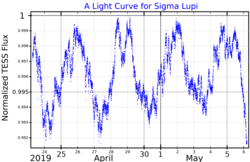 A light curve for Sigma Lupi, plotted from TESS data | |
| Observation data Epoch J2000.0 Equinox J2000.0 (ICRS) | |
|---|---|
| Constellation | Lupus |
| Right ascension | 14 32 37.05667 |
| Declination | −50° 27′ 25.7746″ |
| Apparent magnitude (V) | 4.416 |
| Characteristics | |
| Spectral type | B1/B2 V |
| U−B color index | −0.84 |
| B−V color index | −0.19 |
| Variable type | Uncertain, SX Arietis variable |
| Astrometry | |
| Radial velocity (Rv) | −1.5±2.7 km/s |
| Proper motion (μ) | RA: −29.26 mas/yr Dec.: −15.72 mas/yr |
| Parallax (π) | 5.67 ± 0.19 mas |
| Distance | 580 ± 20 ly (176 ± 6 pc) |
| Absolute magnitude (MV) | −1.79 |
| Details | |
| Mass | 9.0±0.5 M☉ |
| Radius | 4.8±0.5 R☉ |
| Luminosity | 5,754 L☉ |
| Surface gravity (log g) | 4.02±0.10 cgs |
| Temperature | 23,000±550 K |
| Rotation | 3.01938±0.00022 d |
| Rotational velocity (v sin i) | 68±6 km/s |
| Age | 13.4 Myr |
| Other designations | |
| σ Lup, CD−49° 8831, HD 127381, HIP 71121, HR 5425, SAO 241781. | |
| Database references | |
| SIMBAD | data |
Sigma Lupi, Latinized from σ Lupi, is a star in the southern constellation of Lupus. It is visible to the naked eye with an apparent visual magnitude of 4.4. Based upon an annual parallax shift of 5.67 mas as seen from Earth, it is located about 580 light years from the Sun. It is a member of the Upper Centaurus–Lupus subgroup of the nearby Sco OB2 association. D. vander Linden and Christiaan L. Sterken discovered that the star is a variable star, based on data obtained in 1984, and announced their discovery in 1987.
This is a B-type main sequence star with a stellar classification of B1/B2 V. Sigma Lupi is a Helium strong star with an enhanced abundance nitrogen and an underabundance of carbon. Jerzykiewicz and Sterken (1992) showed a small amplitude variability with a period of 3.02 days. This suggests it is a close binary system forming a rotating ellipsoidal variable, although other causes such as rotational modulation can not be ruled out. There is a higher frequency photometric variability with a rate of 10.93482 per day and an amplitude of 0.0031 in visual magnitude, but the cause of this is unknown.
At an age of just 13.4 million years, Sigma Lupi is spinning with a projected rotational velocity of 68 km/s giving it a rotation period of 3.02 days. A magnetic field has been detected with a polar field strength of around 500 G, which is varying longitudinally with an amplitude of around 100 G. The star has an estimated nine times the mass of the Sun and 4.8 times the Sun's radius. It is radiating 5,754 times the solar luminosity from its outer atmosphere at an effective temperature of around 23,000 K.
References
- MAST: Barbara A. Mikulski Archive for Space Telescopes, Space Telescope Science Institute, retrieved 26 September 2022.
- ^ van Leeuwen, F. (2007), "Validation of the new Hipparcos reduction", Astronomy and Astrophysics, 474 (2): 653–664, arXiv:0708.1752, Bibcode:2007A&A...474..653V, doi:10.1051/0004-6361:20078357, S2CID 18759600.
- ^ Henrichs, H. F.; et al. (September 2012), "Discovery of a magnetic field in the early B-type star σ Lupi", Astronomy & Astrophysics, 545: 10, arXiv:1208.4627, Bibcode:2012A&A...545A.119H, doi:10.1051/0004-6361/201219632, S2CID 54184191, A119.
- ^ Johnson, H. L.; et al. (1966), "UBVRIJKL photometry of the bright stars", Communications of the Lunar and Planetary Laboratory, 4 (99): 99, Bibcode:1966CoLPL...4...99J.
- ^ Jerzykiewicz, M.; Sterken, C. (August 1992), "Three periodic variables of early B spectral type", Astronomy and Astrophysics, 261 (2): 477–481, Bibcode:1992A&A...261..477J.
- ^ Koen, Chris; Eyer, Laurent (2002), "New periodic variables from the Hipparcos epoch photometry", Monthly Notices of the Royal Astronomical Society, 331 (1): 45–59, arXiv:astro-ph/0112194, Bibcode:2002MNRAS.331...45K, doi:10.1046/j.1365-8711.2002.05150.x, S2CID 10505995.
- de Bruijne, J. H. J.; Eilers, A.-C. (October 2012), "Radial velocities for the HIPPARCOS-Gaia Hundred-Thousand-Proper-Motion project", Astronomy & Astrophysics, 546: 14, arXiv:1208.3048, Bibcode:2012A&A...546A..61D, doi:10.1051/0004-6361/201219219, S2CID 59451347, A61.
- Anderson, E.; Francis, Ch. (2012), "XHIP: An extended hipparcos compilation", Astronomy Letters, 38 (5): 331, arXiv:1108.4971, Bibcode:2012AstL...38..331A, doi:10.1134/S1063773712050015, S2CID 119257644.
- "sig Lup -- Ellipsoidal variable Star", SIMBAD Astronomical Database, Centre de Données astronomiques de Strasbourg, retrieved 2017-03-10.
- Hoogerwerf, Ronnie (March 2000), "OB association members in the ACT and TRC catalogues", Monthly Notices of the Royal Astronomical Society, 313 (1): 43–65, Bibcode:2000MNRAS.313...43H, doi:10.1046/j.1365-8711.2000.03192.x.
- vander Linden, D.; Sterken, C. (May 1987). "UVBY photometry of southern B- and A stars". Astronomy and Astrophysics, Suppl. Ser. 69: 157–169. Bibcode:1987A&AS...69..157V. Retrieved 27 December 2024.
| Constellation of Lupus | |||||||||||||
|---|---|---|---|---|---|---|---|---|---|---|---|---|---|
| Stars |
| ||||||||||||
| |||||||||||||
| |||||||||||||
| |||||||||||||
| |||||||||||||